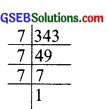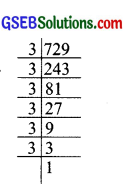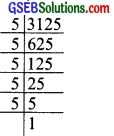Gujarat Board GSEB Textbook Solutions Class 7 Maths Chapter 13 Exponents and Powers Ex 13.1 Textbook Questions and Answers.
Gujarat Board Textbook Solutions Class 7 Maths Chapter 13 Exponents and Powers Ex 13.1
![]()
Question 1.
Find the value of:
(i) 26
(ii) 93
(iii) 112
(iv) 54
Solution:
(i) 26
We have: 26 = 2 x 2 x 2 x 2 x 2 x 2 = 64
Thus, the value of 26 is 64.
(ii) 93
We have: 93 = 9 x 9 x 9 = 729
Thus, the value of 93 is 729.
(iii) 11²
We have: 11² = 11 x 11 = 121
Thus, the value of 11² is 121.
(iv) 54
We have: 54 = 5 x 5 x 5 x 5 = 625
Thus, the value of 54 is 625.
![]()
Question 2.
Express the following in exponential form:
(i) 6 x 6 x 6 x 6
(ii) t x t
(iii) b x b x h x b
(iv) 5 x 5 x 7 x 7 x 7
(v) 2 x 2 x a x a
(vi) a x a x a x c x c x c x c x d
Solution:
(i) We have: 6 x 6 x 6 x 6 = 64
(ii) We have: t x t = t²
(iii) We have: b x b x b x b = b4
(iv) We have: 5 x 5 x 7 x 7 x 7 = 5² x 73
(v) We have: 2 x 2 x a x a = 2² x a2
(vi) We have: a x a x a x c x c x c x c x d
= (a x a x a) x (c x c x c x c) x d
= (a3) x (c4) x d
= a3 x c4 x d
Question 3.
Express each of the following numbers using exponential notation:
(i) 512
(ii) 343
(iii) 729
(iv) 3125
Solution:
(i) 512

We have: 512 = 2 x 2 x 2 x 2 x 2 x 2 x 2 x 2 x 2 = 29
Thus, exponential form of 512 is 29.
(ii) 343

We have: 343 = 7 x 7 x 7
= 73
∴ The exponential notation of 343 is 73
(iii) 729

We have: 729 = 3 x 3 x 3 x 3 = 36
∴ The exponential form of 729 is 36.
(iv) 3125

We have: 3125 = 5 x 5 x 5 x 5 x 5 = 55
Thus, the exponential form of 3125 is 55.
![]()
Question 4.
Identify the greater number, wherever possible, in each of the following:
(i) 43 or 34
(ii) 53 or 35
(iii) 28 or 82
(iv) 1002 or 2100
(v) 210 or 102
Solution:
(i) 43 or 34
Since, 43 = 4 x 4 x 4 = 64
and 34 = 3 x 3 x 3 x 3 = 81
∵ 81 > 64
∴ 35 > 43
(ii) 53 or 35
We have: 53 = 5 x 5 x 5 = 125
35 = 3 x 3 x 3 x 3 x 3 = 243
Since, 243 > 125
i.e. 35 > 53
(iii) 28 or 8²
We have: 28 = 2 x 2 x 2 x 2 x 2 x 2 x 2 x 2 = 256
and 82 = 8 x 8 = 64
Since, 256 > 64
i.e. 28 > 82
(iv) 100² or 2100
We have: 100² = 100 x 100 = 10000
2100 = (210)10
= (2 x 2 x 2 x 2 x 2 x 2 x 2 x 2 x 2 x 2)10
= (1024)10 = [10242]5
= [1024 x 1024]5 = (1048576)5
Since 1048576 > 10000
∴ (1048576)5 > 1002
or (210)10 > 1002
or 2100 > 1002
(v) 210 or 102
We have: 210 = 2 x 2 x 2 x 2 x 2 x 2 x 2 x 2 x 2 x 2 = 1024
and 102 = 10 x 10 = 100
Since, 102 > 100
∴ 210 > 102
Question 5.
Express each of the following as product of powers of their prime factors:
(i) 648
(ii) 405
(iii) 540
(iv) 3,600
Solution:
(i) 648.
We have: 648
= 2 x 324
= 2 x 2 x 162
= 2 x 2 x 2 x 81
= 2 x 2 x 2 x 3 x 27
= 2 x 2 x 2 x 3 x 3 x 9
= 2 x 2 x 2 x 3 x 3 x 3 x 3
= 23 x 34
Thus, 648 = 23 x 34
(ii) 405
We have: 405 = 3 x 135
= 3 x 3 x 45
= 3 x 3 x 3 x 15
= 3 x 3 x 3 x 3 x 5
= 34 x 51
∴ 405 = 34 x 5
(iii) 540
We have: 540 = 2 x 270
= 2 x 2 x 135
= 2 x 2 x 3 x 45
= 2 x 2 x 3 x 3 x 15
= 2 x 2 x 3 x 3 x 3 x 5
= 22 x 33 x 5
∴ 540 = 2² x 33 x 5
(iv) 3600
We have: 3600
= 2 x 1800
= 2 x 2 x 900
= 2 x 2 x 2 x 450
= 2 x 2 x 2 x 2 x 225
= 2 x 2 x 2 x 2 x 3 x 75
= 2 x 2 x 2 x 2 x 3 x 3 x 25
= 2 x 2 x 2 x 2 x 3 x 3 x 5 x 5
= 24 x 32 x 52
Thus, 3600 = 24 x 32 x 52
![]()
Question 6.
Simplify:
(i) 2 x 103
(ii) 7² x 2²
(iii) 23 x 5
(iv) 3 x 44
(v) 0 x 102
(vi) 52 x 33
(vii) 24 x 32
(viii) 32 x 104
Solution:
(i) 2 x 103
∵ 103 = 10 x 10 x 10 = 1000
∴ 2 x 103 = 2 x 1000 = 2000
(ii) 7² x 2²:
∵ 7² = 7 x 7 = 49 and 2² = 2 x 2 = 4
∴ 7² x 2² = 49 x 4 = 196
(iii) 23 x 5:
∵ 23 = 2 x 2 x 2 = 8
∴ 23 x 5 = 8 x 5 = 40
(iv) 3 x 44:
∵ 44 = 4 x 4 x 4 x 4 = 256
∴ 3 x 44 = 3 x 256 = 768
(v) 0 x 102:
∵ 10² = 10 x 10 = 100
∴ 0 x 100 = 0
Thus, 0 x 10² = 0
(vi) 5² x 33:
∵ 5² = 5 x 5 = 25 and 33 = 3 x 3 x 3 = 27
∴ 5² x 33 = 25 x 27 = 675
(vii) 24 x 3²:
∵ 24 = 2 x 2 x 2 x 2 = 16 and 3² = 3 x 3 = 9
∴ 24 x 32 = 16 x 9 = 144
(viii) 32 x 104:
∵ 32 = 3 x 3 = 9
And 104 = 10 x 10 x 10 x 10 = 10000
∴ 32 x 104 = 9 x 10000 = 90000.
Question 7.
Simplify:
(i) (4)3
(ii) (-3) x (-2)3
(iii) (-3)2 x (-5)2
(iv) (-2)3 x (-10)3
Solution:
(i) (-4)3
We have: (-4)3 = (-4) x (-4) x (-4)
= (-1)3 x 4 x 4 x 4
= -1 x 64 = -64
(ii) (-3) x (-2)3:
We have: (-3) x (-2)3
= (-3) x [(-2) x (-2) x (-2)] = (-3)[-8]
= (-3) x (-8) = 24
(iii) (-3)2 x (-5)2
We have: (-3)2 = (-3) x (-3) = 9
and (-5)2 = (-5) x (-5) = 25
(-3)2 x (-5)2 = 9 x 25 = 225
(iv) (-2)3 x (-10)3
We have:
(-2)3 x (-10)3 = [(-2) x (-2) x (-2)] x [(-10) x (-10) x (-10)]
= [-8] X (-1000) = 8000
![]()
Question 8.
Compare the following numbers:
(i) 2.7 x 1012; 1.5 x 108
(ii) 4 x 1014; 3 x 1017
Solution:
(i) 2.7 x 1012; 1.5 x 108
Since 2.7 x 1012 = \(\frac { 27 }{ 10 }\) x 1012 = 27 x 1011
Also, 1.5 x 108 = \(\frac { 15 }{ 10 }\) x 108 = 15 x 107
Now, 27 x 1011 = 27 x 10 x 10 x 10 x 10 x 10 x 10 x 10 x 10 x 10 x 10 x 10 = 27,00,00,00,00,000
and 15 x 107 = 15 x 10 x 10 x 10 x 10 x 10 x 10 x 10 = 150000000
Since, 2700000000000 > 150000000
∴ 2.7 x 1012 > 1.5 x 108
(ii) 4 x 1014; 3 x 1017:
Since 4 x 1014 contains 15 digits, and 3 x 1017 contains 18 digits.
Obviously, a number containing more digits is greater.
∴ 3 x 1017 will be greater than 4 x 1014 or 3 x 1017 > 4 x 1014